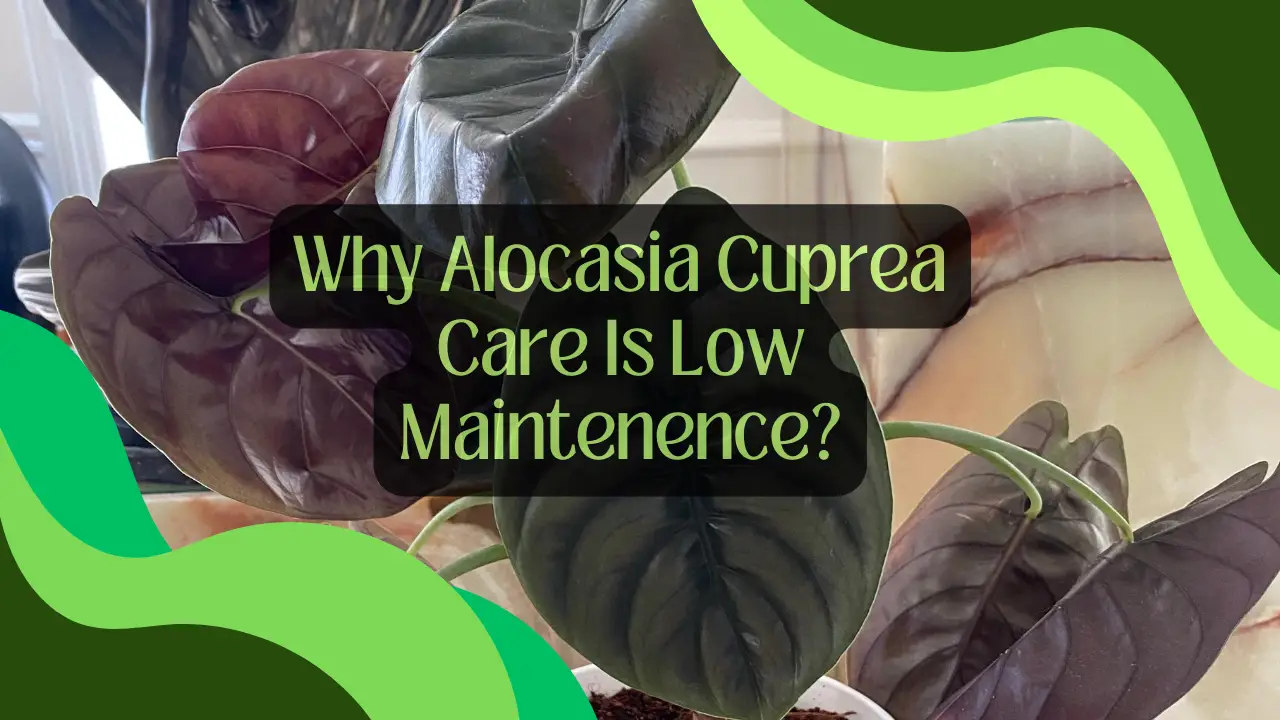Why Alocasia Cuprea Care Is Low Maintenence?

With its lush green leaves boasting an iridescent coppery-bronze sheen, Alocasia cuprea makes a jewel-toned statement in any indoor plant collection. But does caring for this flashy showstopper seem intimidating? Not to worry – providing the right conditions for your Alocasia cuprea is easier than you think.
But caring for this beauty is surprisingly easy! It thrives in bright, indirect light and only needs watering every other week. Alocasia cuprea likes warm temps but does fine at normal indoor levels. Annual repotting and quick leaf wipe-downs are all it takes to keep this plant happy.
Follow these essential care tips to keep your Alocasia cuprea healthy and looking its vibrant best.
Table of Contents
Alocasia Cuprea Care: What Are the Light Requirements?
Low, indirect light, basically. Alocasia cuprea’s stunning metallic-hued leaves really pop when the plant receives adequate light. Situate your Cuprea in a spot with bright, indirect light to maintain its colorful foliage. East or west-facing windows are ideal, providing plenty of gentle sunlight or indirect light.
If direct sun exposure is unavoidable, filter the rays by hanging a sheer curtain. Direct hot sun will scorch the leaves, causing unattractive brown spots. Insufficient light leads to diminished leaf color, slower growth, and a leggy appearance. Aim for roughly 12 hours of quality bright light daily for a robust Alocasia cuprea.
What’s the Best Way to Water This Plant?
While Alocasia cuprea likes consistently moist (but not soggy) soil, it won’t tolerate being waterlogged. Check the top few inches of soil by touch before watering – if it’s dry, it’s time to hydrate your plant. Water thoroughly until the excess drains from the pot’s drainage holes, then empty the saucer so the plant doesn’t sit in standing water.
As a rule of thumb, you’ll need to water about every 7-14 days in spring and summer, reducing frequency in fall and winter during dormancy. If leaf edges begin to brown or yellow, it’s a sign of under-watering. Overwatering leads to roots and stems rotting.
Stick your finger into the soil to monitor moisture levels for foolproof watering. It’s quite easy!
Related article: 10 Low Maintenance Alocasia Plants
What’s the Ideal Humidity for Alocasia Cuprea to Thrive?
Native to the humidity-rich tropical forests of Southeast Asia, Alocasia cuprea thrives when you recreate steamy conditions in your home. Maintain average humidity around 60-80% for optimal growth.
Use a humidifier nearby, mist the leaves daily, or fill a pebble tray with water for passive evaporation. Watch for brown crispy leaf edges or a dull appearance, signals that the air is too dry. Ensuring adequate ambient moisture prevents stressed plants.
Why Warm Atmosphere for Alocasia Plants?
Warm conditions are a must for this tropical plant. Aim to keep your Alocasia cuprea between 65-80 °F during the day and above 60 °F at night. Growth will slow and leaves can be damaged if temperatures dip below 50 °F.
Avoid drafty windows or placing the plant too close to air vents. Move your Cuprea outside only after nighttime lows stay above 60 °F all season long. A summertime vacation outdoors in a shaded spot can be rejuvenating if desired. Shelter from cold and heat extremes keeps Alocasia cuprea looking fabulous.
What’s the Best Potting Mix for Alocasia Cuprea?
Your Alocasia cuprea will thrive when planted in a quality potting medium that mimics the moist, nutrient-rich soils of its rainforest habitat. Choose a mix formulated for tropical plants, containing peat moss, perlite, coco coir, and compost. Or make your own blend using equal parts peat moss or coco coir, perlite, and compost.
The potting mix should hold some moisture but also drain well and air out. Add horticultural charcoal to absorb excess moisture. Re-pot annually in spring, shifting your plant to a slightly larger container. Fertilize monthly during spring and summer using a balanced liquid formula diluted to half strength.
How Should You Prune and Groom Alocasia Cuprea?
Requires minimal pruning to stay shapely. Simply pinch off unsightly, damaged, or dying leaves and stems at the base. Wipe the foliage regularly with a soft damp cloth to prevent dusty buildup which detracts from its beauty.
Remove spent flower bracts as they fade to neaten appearance. An occasional shower or gentle leaf wiping with diluted, mild natural soap can freshen leaves. Avoid harsh chemicals or abrasives which damage the delicate leaf surfaces of this stunning plant.
Recommended articles:
Alocasia Cuprea Raising Challenges
Alocasia cuprea is prone to the same issues faced by many tropical houseplants. Overwatering can lead to root or stem rot – allowing the soil to dry out partially between waterings. Low humidity may cause brown crispy leaf edges. Pests like spider mites, mealybugs, or aphids can be treated by spraying leaves with insecticidal soap.
If limp yellow leaves develop, move to brighter light. Leaves turning black or developing large brown spots can signal sunburn, so adjust exposure. Catch issues early and adjust care to avoid stress-poor growth. With the proper conditions, Alocasia cuprea will reward you with its uniquely jewel-toned, metallic-sheened foliage.
Want to know more? Here is a video to help you understand Alocasia Cuprea care!
Conclusion
Who said exotic houseplants have to be high maintenance? With its jewel-toned leaves, Alocasia cuprea brings a striking tropical style indoors. But this beauty is deceptively easygoing! It thrives with basic care like bright indirect light, biweekly watering, average humidity and warm temps. Repot annually. See? Simple!
Even beginner plant parents can succeed with Alocasia cuprea. Its lush metallic-splashed foliage rewards you with jungle vibes without the fussy care. Low maintenance yet totally glamorous – Alocasia cuprea is a win for both plant and person!






